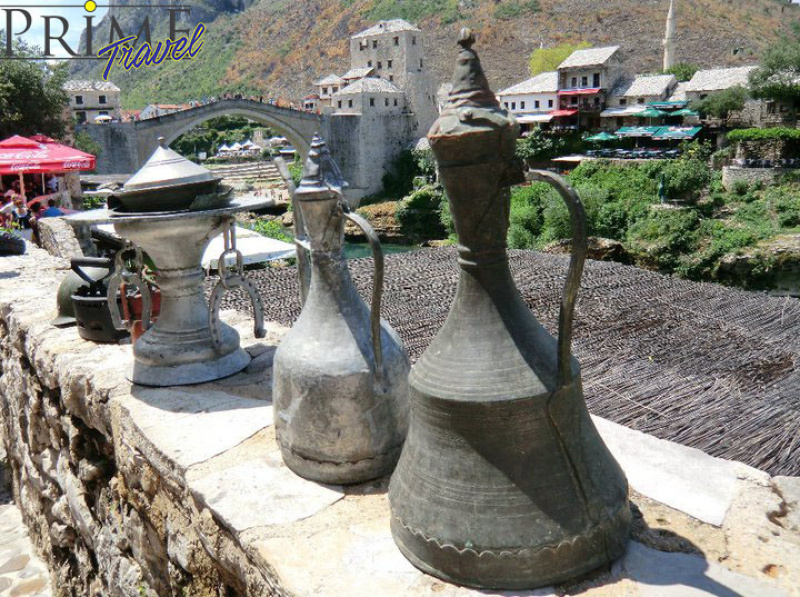
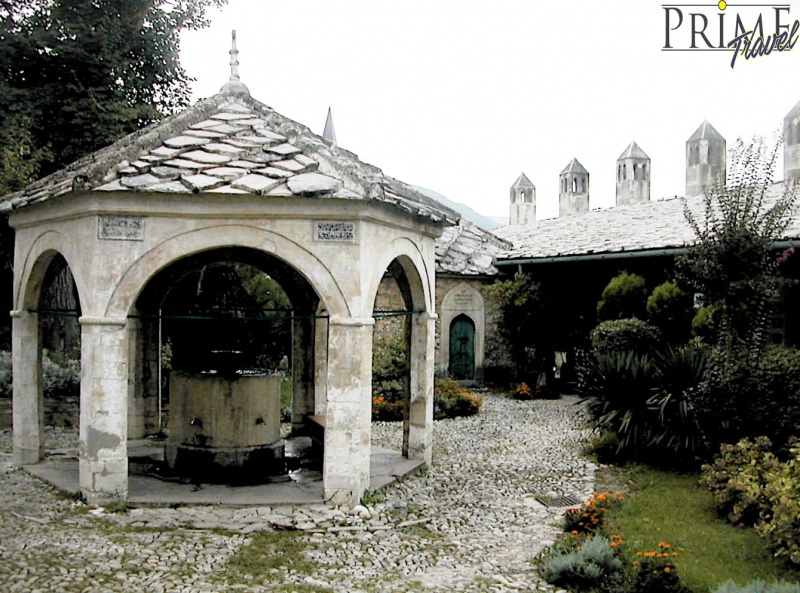
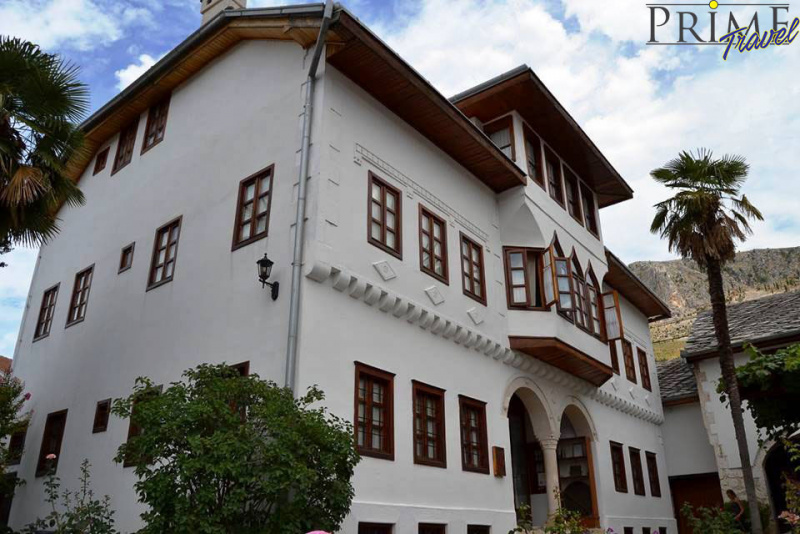
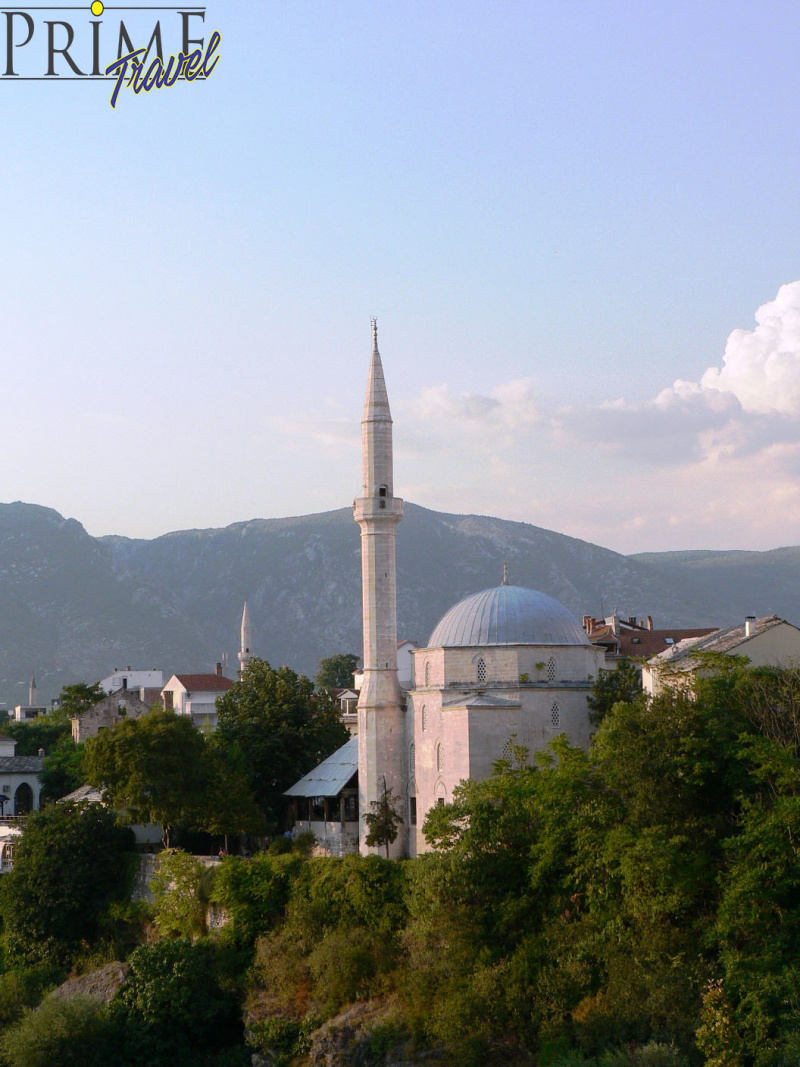
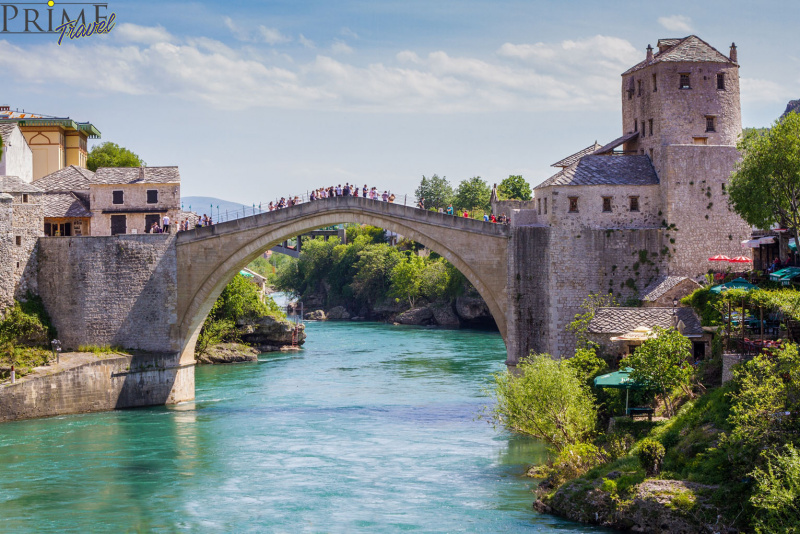
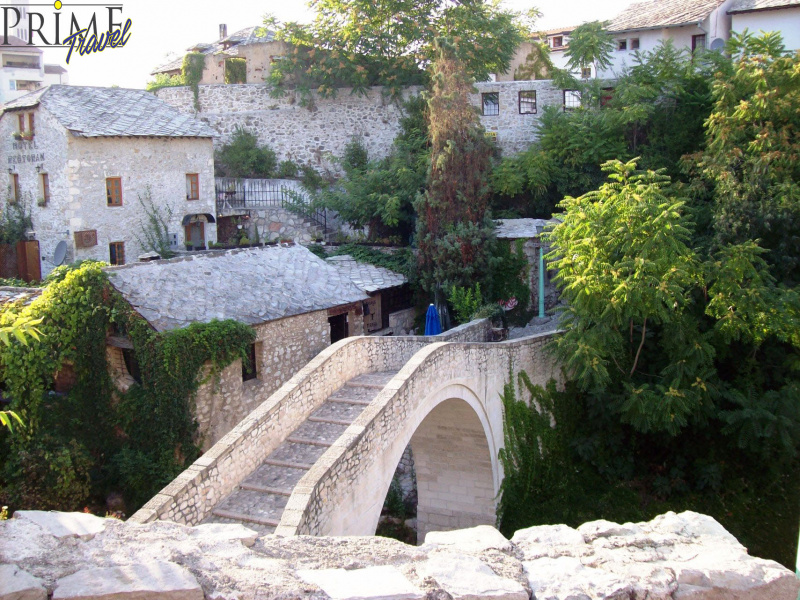
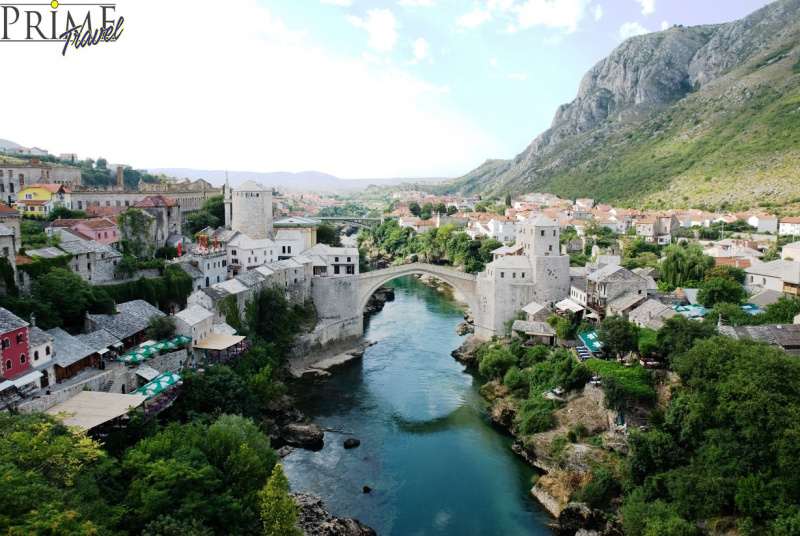
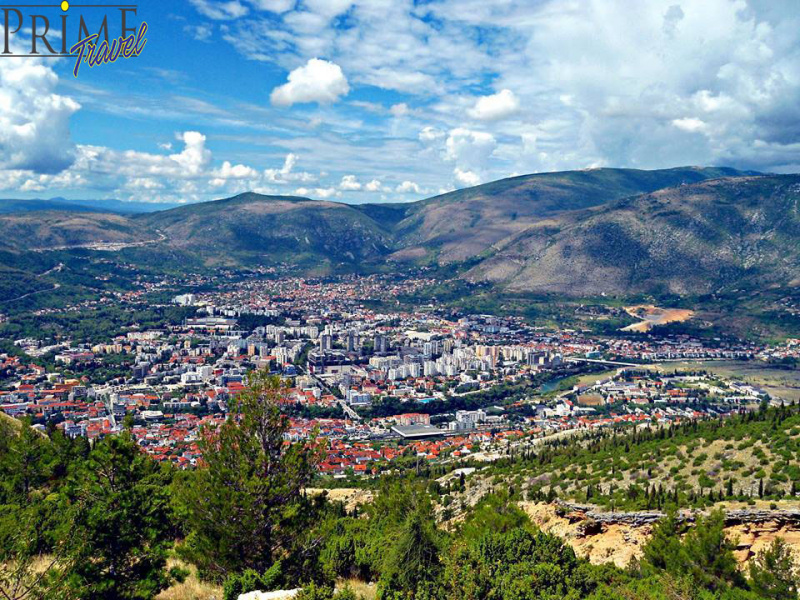
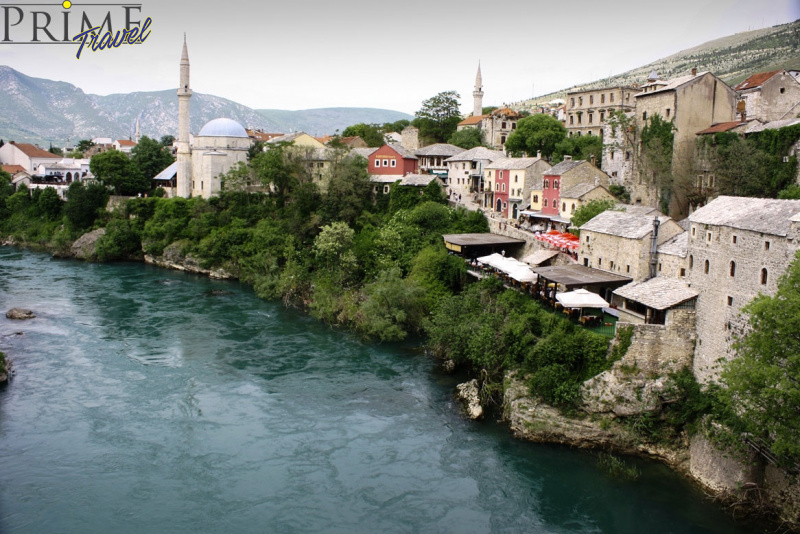
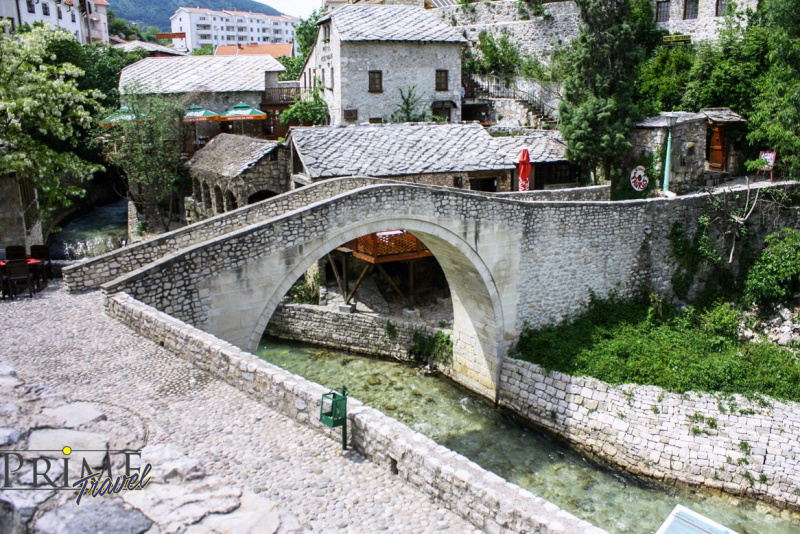
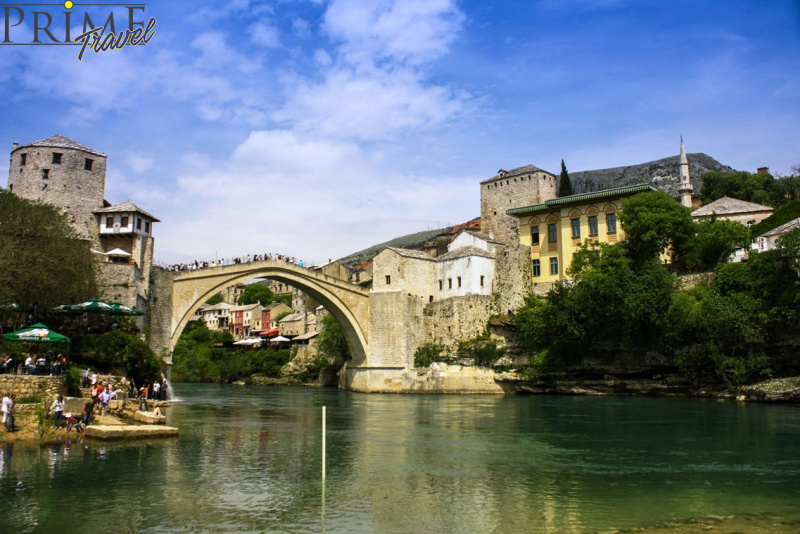
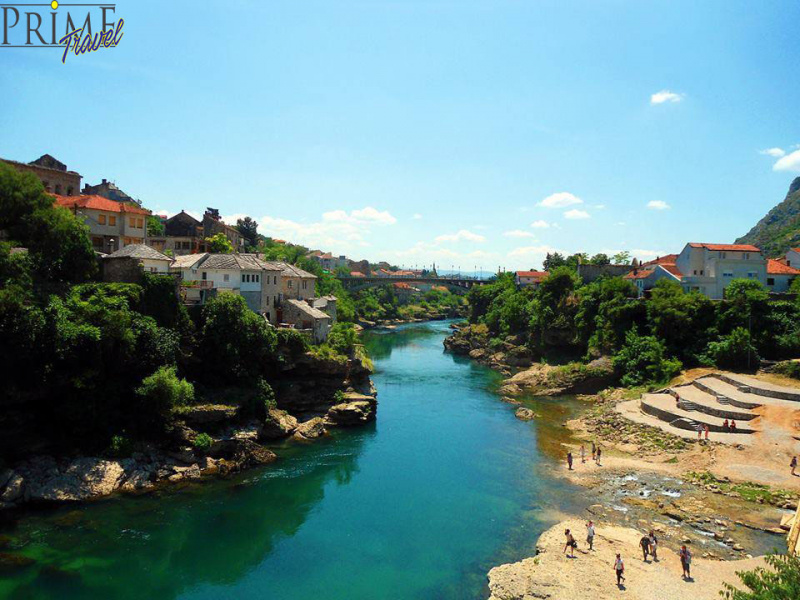
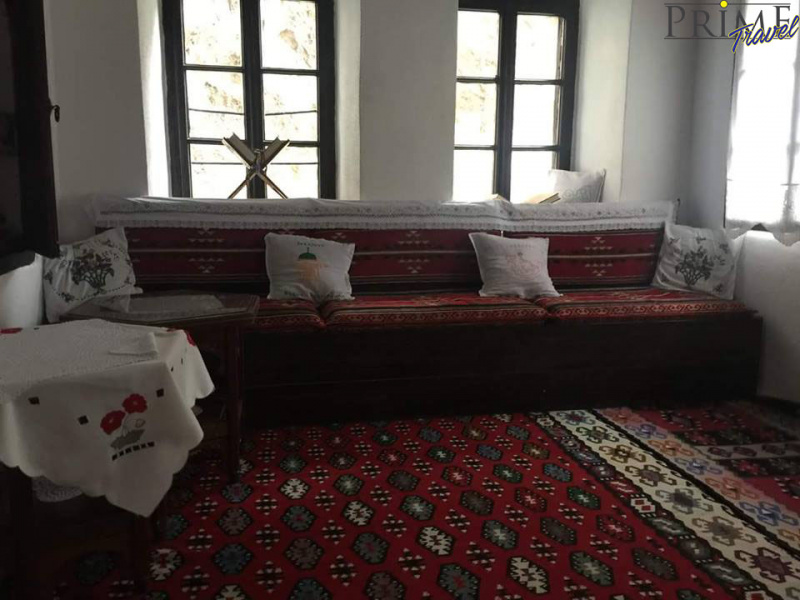
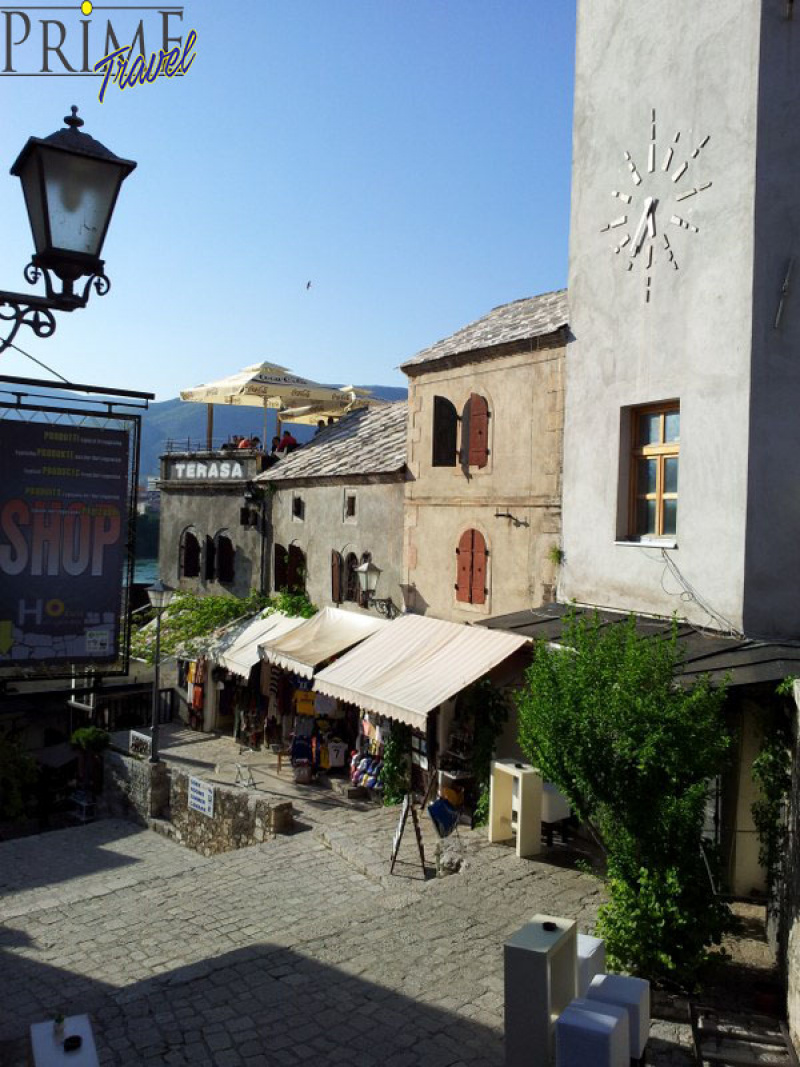
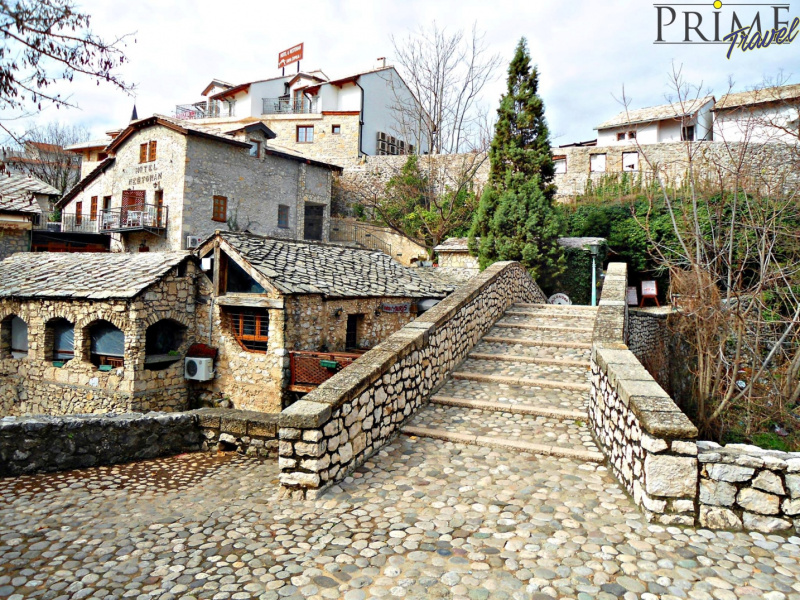
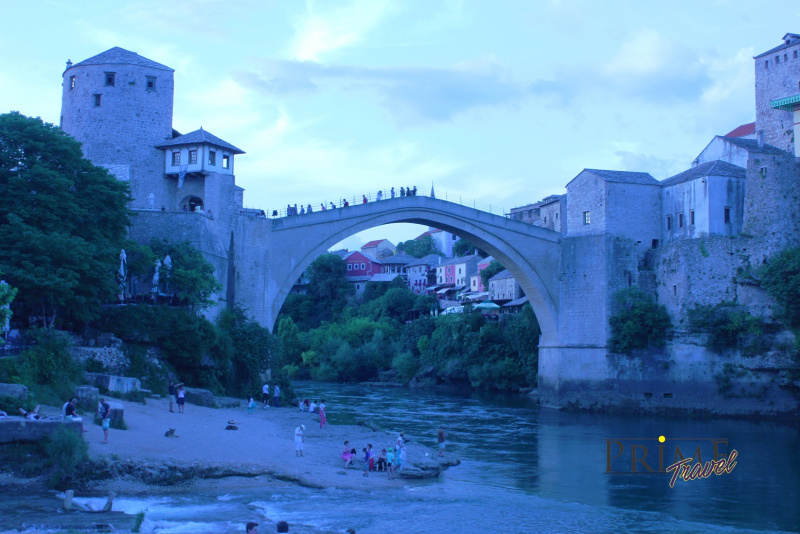
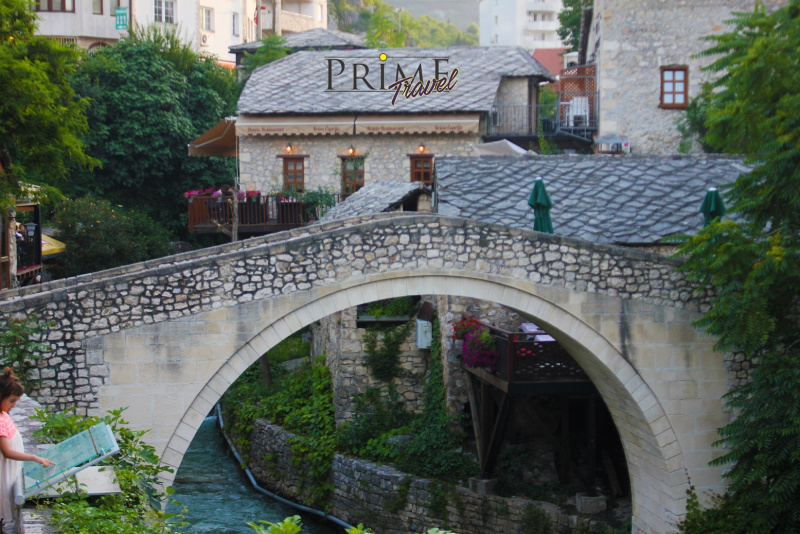
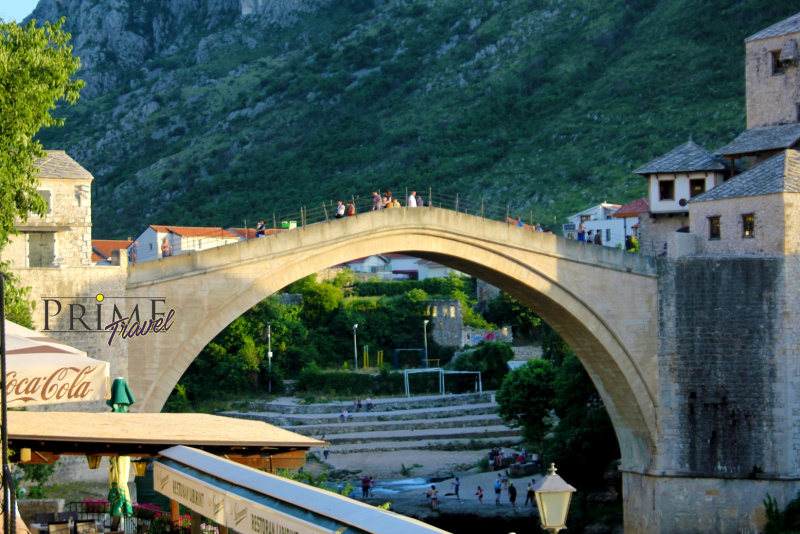
Price: Contact us
Mostar is the town where the north meets the south and west to east, the city where the river Neretva centuries shared culture and religion, the city where the differences and contrasts can be seen and felt in every corner. Mostar is a city in Bosnia and Herzegovina located on the banks of the Neretva River, and was named after the bridge keepers (bridge) on the banks of the Neretva River. Through the center of the city extends the canyon of the Neretva River in Mostar is known by the nickname "city on the Neretva River". Belongs to one of the most beautiful cities in Bosnia and Herzegovina, and in it there is the Old Bridge.
Sights you can visit in Mostar:
Early Christian Basilica – Cim
The remains of the Basilica in Crkvine, Cim, from early Christianity represent the most significant archaeological site from this period. Besides the architecture, on this site there have been found the fragments of the stone plastics, and numerous tombs from the late Hellenic times, the early Christanity and the late Middle Ages. A representative sacral building from the early Christianity has also been found.
Medieval Bosnia tombstones
Among the most mysterious and romantic historical and artistic remains of the country of the Middle Ages, are the monumental tombstones, tombstones, which stand out all over Bosnia Herzegovina (but also in Croatia and Montenegro) and they represent a legendary symbol of these places. Their precise origins are yet unknown and, out of the 60,000 tombstones which have come to light, about 10,000 have symbolic decorations reminding of the sun and the moon, the family, the land, hunting, war and dancing; the most common image depicts a man with his right arm raised. Only a few of these fascinating tombstones are inscribed. Having emerged during the 12th century, these tombstones became common mainly between the 14th and 15th century.
Ottoman Residences (16th -19th century)
In order to breathe in the atmosphere of daily life during the Ottoman period, all one needs to do is visit one of the three Turkish dwellings still present in town: these are the houses of the influential Bišćević (1635), Kajtaz (18th century) and Muslibegović (end of 19th century). Intriguing and well-maintained antique dwellings testify in detail to the residential style and to the real flavour of domestic life in that period. Each house is surrounded by high walls to protect the intimacy of Muslim family life. The delightful internal courtyards have characteristic decorations on the floors, romantic fountains, exotic plants, flowers and fruit trees. Comfort reigns supreme in these interiors, with objects of daily use, precious carpets and small libraries with rare texts. To visit a Turkish residence is a way to come in to touch with a reality often only imagined and then to take it away with you, once you have returned home.
Clock Tower (Sahat Kula) (1630)
Another important monument belonging to the prolific Ottoman period is the Clock Tower standing beside the Herzegovina Museum. This square tower, dated about 1630, is 15 metres high and verbal tradition relates that it was built and commissioned by an influential lady named Fatima - Kaduna Saric. The well known Ottoman writer and traveller Evlija Celebija wrote that the sound of its bells could be heard at a distance of three hours’ walk away. The tower suffered serious damage during the last war and was restored in 1999.
Nesuh-Aga Vučjaković Mosque
Toward the middle of the 16th century – according to some sources around 1564 – Nesuh-Aga Vučjaković erected a mosque beneath the Clock Tower, near the Kujundžiluk and the Old Bridge, also well-known as the ‘mosque under the lime-tree’. This building is unusual due to its artistic influences deriving from the coastal area (Dalmation-Mediterranean School) seen in some of its decorative elements
Koski Mehmed-Pasha Mosque
This mosque was built at the beginning of the 17th century by Koski Mehmed-Pasha. From the minaret, at only five metres from the Neretva River, a spectacular panoramic view of the city can be enjoyed. The welcoming atmosphere within the courtyard offers a pleasant, relaxing break in a unique and romantic context.
Hadzi-Kurt Mosque or Tabačica
This mosque was built between the 16th and 17th centuries, as desired by Hajji Kurt, member of the ancient Mostar Kurt family. Standing on the right bank of the Neretva River, about 100 metres from the Old Bridge, this mosque was next to the antique Tabhana, the district where leather processing workshops were once found; and this fact reveals the mystery of its name, deriving actually from the term Tabaci (leather tanners). A row of small shops and its location make the Tabačica mosque one of the most frequently visited in Mostar.
Karadjoz-Beg Mosque (1557)
Mostar is a city rich in mosques, to be found in each and every district, which well represent the typical Ottoman style. Small but elegant, both from an architectural and a cultural point of view in a wider sense, these are buildings that are well worth visiting not only for the beauty of their interiors but also for tangible evidence of the life and culture of the Ottoman period in Bosnia Herzegovina. The Karadjoz-Beg mosque, slightly outside the city centre, is one of the most representative monuments of sacred Islamic architecture in the 16th century. Built in 1557 according to a project of the Turkish architect Kodža Mimar Sinan, it is internally decorated with sumptuous arabesques and phytomorphic drawings. According to the style and tradition of the period, the mosque is flanked by other buildings in its courtyard: a fountain for washing (sadrvan), an Islamic school (madrasa), a library and even a public kitchen for the poor. Damaged during the war, the Karadjoz-Beg mosque and its minaret have now been re-opened to the public for visiting, after a long and careful restoration. Behind the mosque there is the most antique Muslim cemetery of the city.
Crooked Bridge (Kriva Ćuprija)
On the Radobolja River, near to where it joins the Neretva, close to the Old Bridge, stands the Crooked Bridge, a miniature version of The Old Bridge. Built in 1558, eight years prior to the more famous Old Bridge, it is believed to have been built as a trial attempt for the following, more daring, construction. Destroyed in 2001 by the river flooding, it has recently been rebuilt.
Monumental Partisan Cemetery
In the western part of the city, dominated by extensive green areas, there lies this magnificent Monumental Cemetery. It was built in 1965 (during the period of renewal and reconstruction following the end of World War II) by the architect Bogdan Bogdanovic, in memory of the partisans of Mostar who lost their lives during the war. The Cemetery has 661 tombstones and every stone has its own symbolic significance, like the Monumental complex itself.
Orthodox Church
The old Orthodox Church was built in 1834 in the area of Byelusine. An important example of sacred orthodox architecture, the Church guards a beautiful icon of the Virgin Mary, a wooden iconostasis with several Russian, Venetian and local icons dating back to between the 15th and 18th centuries. The new Church, located in a hilly part of the city was built between 1863 and 1873 according to the project of artist Spasoje Vulić. Due to a lack of understanding between Vulić and the people of Mostar, the work was finished by Andreja Damjanov who had just finished constructing the Orthodox Church of Sarajevo. The bombings of the last war destroyed almost all of this wonderful building and its artistic inheritance has been lost. Nowadays, governmental bodies are working hard to be able to proceed with its reconstruction.
Catholic Church and Franciscan Monastery
In Mostar, the Ottomans helped build a Catholic church in 1866. The church was destroyed during the 1992 war and the new, larger structure was erected in 2000 on the foundations of the previous building. The Complex is also proud of its library with its prestigious 50,000 ancient volumes of both the western and eastern worlds, and in fact it is the largest of all the libraries with such characteristics in the whole of Herzegovina. The building also holds an important art collection with works of Italian Masters of the 16th and 17th centuries, apart from works of more contemporary art.
Austrian-Hungarian Buildings (19th-20th c.)
In Mostar, there are numerous palaces to be seen, built during the Austrian-Hungarian period, which demonstrates the blending of western and eastern architectural styles (pseudo-Moresque style). Amongst the most interesting: the Secondary School (1898), the most prestigious school of the city (in Španski trg) and the Public Bath (1914), built according to a project of the architect Rudolf Tonnies with the support of Miroslav Loose. These are imposing buildings in the Austrian-Hungarian style where the Moorish ornamental features are particularly notable. In the Public Bath, recently restored and now open to the public, you can swim in covered swimming pools or ask for relaxing massages and various treatments. Moreover, a fitness gym, a solarium and a beauty salon will let you find a pleasant and relaxing way of combining a knowledge of the city with well-being.
Public Turkish Bath
The use of public baths (hammam) was common practice in the Ottoman era. The Turkish public bath near the Tabačica mosque and the Tabhana (the town district encompassing leather processing workshops) was built between the end of the 16th century and the beginning of the 17th century in the classical Ottoman architectural style. It is the only Turkish bath still existing in Mostar and one of the few remaining examples in the whole of Herzegovina. The Hammam comprises a central room used as an antechamber, an intermediate space (tepidarium) and the room for the bath itself, called calidarium. This type of building is conceived for a purely functional, without any sign of wealth: the external parts usually have no decorations and, surrounding the Turkish bath, there often stands a mosque, an Islamic school or a public kitchen. The Cejvan Ćehajin Hamam has no windows and has a roof made of domes designed to protect the privacy of its users. At the end of the Ottoman era, the Bath ceased to be used and, restored during the reconstruction of the historic centre, thanks to the aid of France and Turkey, it is nowadays used to host exhibitions and cultural events.
The Old Bazaar
In the centre of the city, you can admire one of the oldest parts of Mostar, the Kujundžiluk, which winds along a small, pretty, cobbled street, dating back to the middle of the 16th century, where characteristic crafts shops and traditional restaurants are found. In the past, it was the pulsing heart of the business world in the whole of the region with more than 500 workshops in the Ottoman era. Even with the changes due to the passing of time, this road has maintained its ancient outward appearance, characterized by its ever-present mosques and small inns – and has maintained, up till now, some of its most characteristic crafts, such as the working of copper and the weaving of carpets. Together with the Old Bridge, undoubtedly the chief attraction of the whole district, the Old Bazaar represents a characteristic example of the architecture and, at the same time, of the daily life of Mostar, as seen in the vitality of the workshops, in the little restaurants (where you can taste excellent traditional dishes) and in the crowded cafes which characterize the local atmosphere.
Tara and Halebija Towers
The two towers, standing on opposite sides of the Old Bridge, soar as architectural buttresses of the bridge itself, and seem to be stone guardians controlling the way. On the east bank rises the semi-circular Tara Tower, a deposit for ammunitions in the Ottoman era and, today, seat of the Museum of the Old Bridge.h e Halebija, on the west side, was once the prison on its lower floors, and small barracks on its upper fl oors, also used as a look-out post. Behind the Tara, on the left bank of the Neretva River, is the Herceguša Tower, built in the first half of the 15th century during the reign of Herceg Stjepan Vukčić Kosača.
The Old Bridge
An almost instinctive image comes to mind when one thinks of Mostar and that is that of its splendid Old Bridge; it thereby follows that this stone masterpiece is the monument that has given its name to the city and which symbolizes its many significances.It was built during the Ottoman period by the Turkish architect Hajrudin and commissioned by the sultan Soliman the Magnificent; it was completed in 1566 after nine years’ work. Right from the start, the bridge became part of various local legends, one of which narrates the stubbornness of Hajrudin who stopped underneath it for three days and three nights in order to demonstrate its absolute solidity. The old Bridge joins the two banks of the Neretva River together and is situated between the Herceguša and Tara Towers, on the left bank, and the Halebija on the right. And, some historic sources confirm that this has been common practice since the very construction of the bridge. Youngsters coming from all over the world meet here to participate in an impressive athletic event. The meeting takes its inspiration from a local ritual that has always taken place during summer, when the youth of the Diving Club (which has its headquarters nearby the Halebija Tower) show off their own virility by leaping into the icy waters of the Neretva River: a unique spectacle with a complex and all-embracing ritual. Amidst the frenetic applause of the crowd, these young men reach the highest point of the bridge; then, in the typical silence that precedes a tough trial, they jump off in an exciting thrill, and this continues constantly all day long. The new Old Bridge of Mostar was officially inaugurated in July 2004 to symbolize, once again, the city of Mostar and its wish for its rebirth, based on its glorious past and around its most beloved monument. In July 2005, the Old Bridge and the entire old city became officially a part of the Cultural Heritage of the UNESCO.